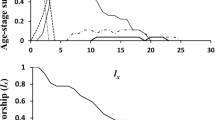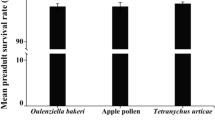Abstract
Neoseiulus californicus (McGregor) (Acari: Phytoseiidae) is one of the most efficient biological control agents of tetranychid mites and is commercially used in various countries around the world. In this study, four artificial diets were tested as an alternative food source for rearing N. californicus, and life table studies were performed to evaluate the nutritional value of the diets. Further, the performance of N. californicus reared for seven consecutive generations on the artificial diet enriched with Ephestia kuehniella Zeller eggs was assessed. The egg and larval periods of N. californicus did not differ among the natural prey (Tetranychus urticae Koch) and artificial diets, but the developmental times of the nymphal stages were significantly longer on any of the artificial diets than on the natural prey. The total fecundity of N. californicus was reduced when the predator was fed on any of the artificial diets as compared with T. urticae (54.33 eggs per female). Among the artificial diets, fecundity of N. californicus was best on a basic artificial diet enriched with E. kuehniella (AD2) (41.32 eggs per female). Moreover, AD2 did not significantly affect the longevity and reproduction of N. californicus females after long-term rearing on this artificial diet. The predation and reproduction capacities of N. californicus reared on AD2 for up to four generations were significantly reduced when the predator was switched to natural prey on the first day, but generally improved from the second to third day on. In conclusion, artificial diets supplemented with an extract of E. kuehniella eggs (20%) may have potential for use in the mass rearing of N. californicus.
Similar content being viewed by others
References
Abou-Awad B, Reda A, Elsawi S (1992) Effects of artificial and natural diets on the development and reproduction of two phytoseiid mites Amblyseius gossipi and Amblyseius swirskii (Acari: Phytoseiidae). Int J Trop Insect Sci 13:441–445
Akca I, Ayvaz T, Yazici E, Smith CL, Chi H (2015) Demography and population projection of Aphis fabae (Hemiptera: Aphididae): with additional comments on life table research criteria. J Econ Entomol 108:1466–1478. https://doi.org/10.1093/jee/tov187
Atlihan R, Kasap İ, Özgökçe MS, Polat-Akköprü E, Chi H (2017) Population growth of Dysaphis pyri (Hemiptera: Aphididae) on different pear cultivars with discussion on curve fitting in life table studies. J Econ Entomol 110:1890–1898
Bolckmans KJF, van Houten YM (2006a) Mite composition, use thereof, method for rearing the phytoseiid predatory mite Amblyseius swirskii, rearing system for rearing said phytoseiid mite and methods for biological pest control on a crop. WO Patent WO/2006/057552
Bolckmans KJF, van Houten YM (2006b) Mite composition, use thereof, method for rearing a phytoseiid predatory mite, rearing system for rearing said phytoseiid predatory mite and methods for biological pest control on a crop. WO Patent WO/2006/071107
Canlas LJ, Amano H, Ochiai N, Takeda M (2006) Biology and predation of the Japanese strain of Neoseiulus californicus (McGregor) (Acari: Phytoseiidae). Syst Appl Acarol 11:141–157
Castagnoli M, Simoni S (1999) Effect of long-term feeding history on functional and numerical response of Neoseiulus californicus (Acari: Phytoseiidae). Exp Appl Acarol 23:217–234
Chant D (1985) Systematics and morphology. In: Helle W, Sabelis MW (eds) Spider mites: their biology, natural enemies and control, vol 1B. Elsevier. Amsterdam, Netherlands, pp 3–32
Chi H (1988) Life-table analysis incorporating both sexes and variable development rates among individuals. Environ Entomol 17:26–34
Chi H, Liu H (1985) Two new methods for the study of insect population ecology. Bull Inst Zool Acad Sin 24:225–240
Christiansen IC, Szin S, Schausberger P (2016) Benefit-cost trade-offs of early learning in foraging predatory mites Amblyseius swirskii. Sci Rep 6:23571. https://doi.org/10.1038/srep23571
De Clercq P (2004) Culture of natural enemies on factitious foods and artificial diets. In: Capinera JL (ed) Encyclopedia of entomology, vol 1. Kluwer Acad. Publication, Dordrecht, pp 650–652
De Clercq P, Arijs Y, van Meir T, van Stappen G, Sorgeloos P, Dewettinck K, Rey M, Grenier S, Febvay G (2005a) Nutritional value of brine shrimp cysts as a factitious food for Orius laevigatus (Heteroptera: Anthocoridae). Biocontrol Sci Technol 15:467–479
De Clercq P, Bonte M, van Speybroeck K, Bolckmans K, Deforce K (2005b) Development and reproduction of Adalia bipunctata (Coleoptera: Coccinellidae) on eggs of Ephestia kuehniella (Lepidoptera: Phycitidae) and pollen. Pest Manag Sci 61:1129–1132
De Clercq P, Coudron TA, Riddick EW (2014) Production of heteropteran predators. In: Morales-Ramos JA, Rojas G, Shapiro-Ilan D (eds) Mass production of beneficial organisms: invertebrates and entomopathogens. Elsevier, London, pp 57–100
Gillespie DR (1989) Biological control of thrips (Thysanoptera: Thripidae) on greenhouse cucumber by Amblyseius cucumeris. Entomophaga 34:185–192
Goleva I, Zebitz CP (2013) Suitability of different pollen as alternative food for the predatory mite Amblyseius swirskii (Acari, Phytoseiidae). Exp Appl Acarol 61:259–283
Grenier S, De Clercq P (2003) Comparison of artificially vs. naturally reared natural enemies and their potential for use in biological control. In: van Lenteren J (ed) Quality control and production of biological control agents: theory and testing procedures. CABI Publishing, Wallingford, pp 115–131
Henaut Y, Alauzet C, Ferran A, Williams T (2000) Effect of nymphal diet on adult predation behavior in Orius majusculus (Heteroptera: Anthocoridae). J Econ Entomol 93:252–255
Huang YB, Chi H (2012) Assessing the application of the Jackknife and Bootstrap techniques to the estimation of the variability of the net reproductive rate and gross reproductive rate: a case study in Bactrocera cucurbitae (Coquillett) (Diptera: Tephritidae). J Agric For 61:37–45
Kennett C, Hamai J (1980) Oviposition and development in predaceous mites fed with artificial and natural diets (Acari: Phytoseiidae). Entomol Exp Appl 28:116–122
Khanamani M, Fathipour Y, Talebi AA, Mehrabadi M (2017a) Linking pollen quality and performance of Neoseiulus californicus (Acari: Phytoseiidae) in two-spotted spider mite management programmes. Pest Manag Sci 73:452–461
Khanamani M, Fathipour Y, Talebi AA, Mehrabadi M (2017b) Evaluation of different artificial diets for rearing the predatory mite Neoseiulus californicus (Acari: Phytoseiidae): diet-dependent life table studies. Acarol 57:407–419
Kutner MH, Nachtsheim CJ, Neter J, Li W (2005) Applied linear statistical models. McGraw-Hill, New York
Marafeli PP, Reis PR, da Silveira EC, Souza-Pimentel GC, de Toledo MA (2014) Life history of Neoseiulus californicus (McGregor, 1954) (Acari: Phytoseiidae) fed with castor bean (Ricinus communis L.) pollen in laboratory conditions. Braz J Biol 74:691–697
McMurtry JA, Scriven G (1966) Effects of artificial foods on reproduction and development of four species of phytoseiid mites. Ann Entomol Soc Am 59:267–269
McMurtry JA, Moraes GJD, Sourassou NF (2013) Revision of the lifestyles of phytoseiid mites (Acari: Phytoseiidae) and implications for biological control strategies. Syst Appl Acarol 18:297–320
Nguyen DT, Vangansbeke D, Lv X, De Clercq P (2013) Development and reproduction of the predatory mite Amblyseius swirskii on artificial diets. BioControl 58:369–377
Nguyen DT, Vangansbeke D, De Clercq P (2014) Artificial and factitious foods support the development and reproduction of the predatory mite Amblyseius swirskii. Exp Appl Acarol 62:181–194
Nguyen DT, Bouguet V, Spranghers T, Vangansbeke D, De Clercq P (2015a) Beneficial effect of supplementing an artificial diet for Amblyseius swirskii with Hermetia illucens haemolymph. J Appl Entomol 139:342–351
Nguyen DT, Vangansbeke D, De Clercq P (2015b) Performance of four species of phytoseiid mites on artificial and natural diets. Biol Control 80:56–62
Ogawa Y, Osakabe M (2008) Development, long-term survival, and the maintenance of fertility in Neoseiulus californicus (Acari: Phytoseiidae) reared on an artificial diet. Exp Appl Acarol 45:123–136
Ramakers PMJ, van Lieburg MJ (1982) Start of commercial production and introduction of Amblyseius mckenziei Sch. & PR. (Acarina: Phytoseiidae) for the control of Thrips tabaci Lind. (Thysanoptera: Thripidae) in glasshouses. Med Fac Landbouww Rijksuniv Gent 47:541–545
Riddick EW (2009) Benefits and limitations of factitious prey and artificial diets on life parameters of predatory beetles, bugs, and lacewings: a mini-review. BioControl 54:325–339
Shehata K, Weismann L (1972) Rearing the predacious mite Phytoseiulus persimilis Athias-Henriot on artificial diet (Acarina: Phytoseiidae). Biol Bratisl 27:609–615
Šidák Z (1967) Rectangular confidence regions for the means of multivariate normal distributions. J Am Stat Assoc 62:626–633
Song ZW, Zheng Y, Zhang BX, Li DS (2016) Prey consumption and functional response of Neoseiulus californicus and Neoseiulus longispinosus (Acari: Phytoseiidae) on Tetranychus urticae and Tetranychus kanzawai (Acari: Tetranychidae). Syst Appl Acarol 21:936–946
van Lenteren JC (2012) The state of commercial augmentative biological control: plenty of natural enemies, but a frustrating lack of uptake. BioControl 57:1–20
Vangansbeke D, Nguyen DT, Audenaert J, Verhoeven R, Gobin B, Tirry L, De Clercq P (2014) Performance of the predatory mite Amblydromalus limonicus on factitious foods. BioControl 59:67–77
Xu XN, Wang BM, Wang ED, Zhang ZQ (2013) Comments on the identity of Neoseiulus californicus sensu lato (Acari: Phytoseiidae) with a redescription of this species from southern China. Syst Appl Acarol 18:329–344
Acknowledgements
Zi-Wei Song and Dun-Song Li were supported by the National Key R&D Program of China (2017YFD0201000), the Science and Technology Planning Project of Guangdong Province, China (2015A020209071), the Key Science and Technology Project of Yunnan Tobacco Company (2017YN13). The authors acknowledge the Grant for Overseas Training Projects from the Guangdong Academy of Agricultural Sciences for supporting the international cooperation. Duc Tung Nguyen and Patrick De Clercq were supported by additional funds from the Vietnam National Foundation for Science and Technology Development (NAFOSTED) and the Research Foundation - Flanders (FWO) under grant number FWO.106-NN.2015.01. Thanks also go to Thomas Spranghers for providing the prepupae of the black soldier fly and his useful suggestions, and to Wim Jonckheere and Viet Ha Nguyen for support during the laboratory experiments. Professor Hsin Chi from Omer Halisdemir University is acknowledged for providing the updates for the TWOSEX-MSChart program and for his kind advice on the analysis.
Author information
Authors and Affiliations
Corresponding authors
Additional information
Handling Editor: Marta Montserrat.
Rights and permissions
About this article
Cite this article
Song, ZW., Nguyen, D.T., Li, DS. et al. Continuous rearing of the predatory mite Neoseiulus californicus on an artificial diet. BioControl 64, 125–137 (2019). https://doi.org/10.1007/s10526-019-09923-7
Received:
Accepted:
Published:
Issue Date:
DOI: https://doi.org/10.1007/s10526-019-09923-7




